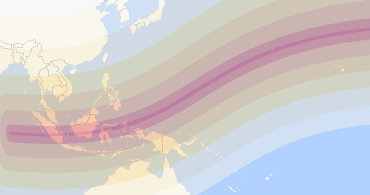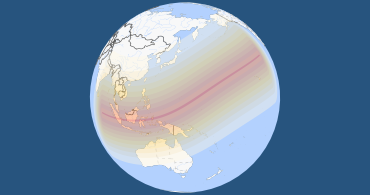The Total Solar Eclipse was visible from parts of Indonesia including Sumatra, Borneo, and Sulawesi, and from locations in the Pacific Ocean.
Observers in northern and eastern Australia, South Asia, and East Asia were able to see a partial eclipse.
The eclipse started at 23:19 UTC on March 8, 2016, and its maximum point was at 01:59 UTC on March 9, 2016. Totality lasted for 4 minutes and 9 seconds.
This eclipse wasn't visible in Columbus - Which upcoming eclipses can be seen in your location?
Where the Eclipse Was Seen
Try our new interactive eclipse maps. Zoom in and search for accurate eclipse times and visualizations for any location.
Path of the Eclipse Shadow
Regions that saw, at least, a partial eclipse: Much of Asia, Much of Australia, West in North America, Pacific, Indian Ocean.
This eclipse wasn't visible in Columbus - Which upcoming eclipses can be seen in your location?
Eclipse Shadow Path
0%
>0%
40%
90%
100%
The dark areas symbolize night and twilight.
When the Eclipse Happened Worldwide — Timeline
The eclipse started at one location and ended at another. The times below are actual times (in UTC) when the eclipse occurred. This calculation uses a Delta T value of 68.2 seconds.
| Eclipse Stages Worldwide | UTC Time | Local Time in Columbus* |
|---|---|---|
| First location to see the partial eclipse begin | Mar 8 at 23:19:20 | Mar 8 at 6:19:20 pm |
| First location to see the full eclipse begin | Mar 9 at 00:15:57 | Mar 8 at 7:15:57 pm |
| Maximum Eclipse | Mar 9 at 01:57:12 | Mar 8 at 8:57:12 pm |
| Last location to see the full eclipse end | Mar 9 at 03:38:19 | Mar 8 at 10:38:19 pm |
| Last location to see the partial eclipse end | Mar 9 at 04:34:55 | Mar 8 at 11:34:55 pm |
* These local times do not refer to a specific location but indicate the beginning, peak, and end of the eclipse on a global scale, each line referring to a different location. This eclipse isn't visible in Columbus.
Upcoming eclipses visible in Columbus
Next Total Solar Eclipse will be on Aug 21, 2017
Eclipse calculations usually accurate to a few seconds
Countries Where the Eclipse Is Visible
| Country | Type | Start of Eclipse | End of Eclipse |
|---|---|---|---|
| Indonesia | Total Solar Eclipse | 6:19 am WIB | 11:49 am WIT |
| Australia | Partial Solar Eclipse | 7:29 am AWST | 12:36 pm PGT |
| Bangladesh | Partial Solar Eclipse | 6:03 am BST | 7:23 am BST |
| Bhutan | Partial Solar Eclipse | 6:09 am BTT | 7:20 am BTT |
| Brunei | Partial Solar Eclipse | 7:29 am BNT | 9:55 am BNT |
| Cambodia | Partial Solar Eclipse | 6:33 am ICT | 8:43 am ICT |
| Canada | Partial Solar Eclipse | 6:36 pm PST | 7:07 pm PST |
| China | Partial Solar Eclipse | 7:51 am CST | 10:19 am CST |
| Christmas Island | Partial Solar Eclipse | 6:19 am CXT | 8:26 am CXT |
| Cocos (Keeling) Islands | Partial Solar Eclipse | 6:05 am CCT | 7:45 am CCT |
| East Timor | Partial Solar Eclipse | 8:28 am TLT | 11:06 am TLT |
| Guam | Partial Solar Eclipse | 10:21 am ChST | 1:24 pm ChST |
| Hong Kong | Partial Solar Eclipse | 8:04 am HKT | 9:57 am HKT |
| India | Partial Solar Eclipse | 5:23 am IST | 6:55 am IST |
| Japan | Partial Solar Eclipse | 9:18 am JST | 12:51 pm JST |
| Kiribati | Partial Solar Eclipse | 1:22 pm GILT | 6:06 pm LINT |
| Laos | Partial Solar Eclipse | 6:40 am ICT | 8:43 am ICT |
| Macau | Partial Solar Eclipse | 8:04 am CST | 9:55 am CST |
| Malaysia | Partial Solar Eclipse | 7:22 am MYT | 10:04 am MYT |
| Marshall Islands | Partial Solar Eclipse | 1:10 pm | 4:11 pm |
| Micronesia | Partial Solar Eclipse | 10:02 am CHUT | 2:48 pm KOST |
| Myanmar | Partial Solar Eclipse | 6:04 am MMT | 8:02 am MMT |
| Nauru | Partial Solar Eclipse | 1:12 pm NRT | 3:38 pm NRT |
| Nepal | Partial Solar Eclipse | 6:08 am NPT | 7:03 am NPT |
| North Korea | Partial Solar Eclipse | 9:40 am PYT | 10:51 am PYT |
| Northern Mariana Islands | Partial Solar Eclipse | 10:23 am ChST | 1:30 pm ChST |
| Palau | Partial Solar Eclipse | 8:42 am | 11:50 am |
| Papua New Guinea | Partial Solar Eclipse | 9:52 am PGT | 1:14 pm PGT |
| Philippines | Partial Solar Eclipse | 7:32 am | 10:26 am |
| Russia | Partial Solar Eclipse | 11:35 am VLAT | 3:32 pm PETT |
| Singapore | Partial Solar Eclipse | 7:22 am SGT | 9:33 am SGT |
| Solomon Islands | Partial Solar Eclipse | 11:32 am SBT | 2:06 pm SBT |
| South Korea | Partial Solar Eclipse | 9:52 am KST | 11:36 am JST |
| Sri Lanka | Partial Solar Eclipse | 6:12 am IST | 6:47 am IST |
| Taiwan | Partial Solar Eclipse | 8:09 am CST | 10:16 am CST |
| Thailand | Partial Solar Eclipse | 6:26 am ICT | 8:40 am ICT |
| Tuvalu | Partial Solar Eclipse | 1:59 pm TVT | 3:21 pm TVT |
| US Minor Outlying Islands | Partial Solar Eclipse | 1:22 pm WAKT | 5:29 pm SST |
| United States | Partial Solar Eclipse | 4:02 pm HST | 6:33 pm HST |
| Vanuatu | Partial Solar Eclipse | 12:33 pm VUT | 1:40 pm VUT |
| Vietnam | Partial Solar Eclipse | 6:31 am ICT | 8:46 am ICT |
All times shown in this table are local time. (Note: more than one time zone is listed.)
How Many People Can See This Eclipse?
| Number of People Seeing... | Number of People* | Fraction of World Population |
|---|---|---|
| Any part of the eclipse | 3,200,000,000 | 42.69% |
| At least 10% partial | 1,950,000,000 | 26.00% |
| At least 20% partial | 876,000,000 | 11.67% |
| At least 30% partial | 562,000,000 | 7.49% |
| At least 40% partial | 487,000,000 | 6.48% |
| At least 50% partial | 392,000,000 | 5.22% |
| At least 60% partial | 333,000,000 | 4.44% |
| At least 70% partial | 300,000,000 | 3.99% |
| At least 80% partial | 226,000,000 | 3.02% |
| At least 90% partial | 57,400,000 | 0.76% |
| Totality or annularity | 10,300,000 | 0.14% |
* The number of people refers to the resident population (as a round number) in areas where the eclipse is visible. timeanddate has calculated these numbers using raw population data provided by the Center for International Earth Science Information Network (CIESIN) at Columbia University. The raw data is based on population estimates from the year 2000 to 2020.

An Eclipse Never Comes Alone!
A solar eclipse always occurs about two weeks before or after a lunar eclipse.
Usually, there are two eclipses in a row, but other times, there are three during the same eclipse season.
This is the first eclipse this season.
Second eclipse this season: March 23, 2016 — Penumbral Lunar Eclipse

